Phala, Phāla: 50 definitions
Introduction:
Phala means something in Buddhism, Pali, Hinduism, Sanskrit, Jainism, Prakrit, the history of ancient India, Marathi, Hindi, biology. If you want to know the exact meaning, history, etymology or English translation of this term then check out the descriptions on this page. Add your comment or reference to a book if you want to contribute to this summary article.
Alternative spellings of this word include Fal.
Images (photo gallery)
In Hinduism
Shaktism (Shakta philosophy)
Source: Wisdom Library: ŚāktismPhala (फल, “fruit”):—One of the five preliminary oblations (upacāra) to be offered during the worship of Gaṇeśa, Durgā, Śiva and Viṣṇu, according to the Durgāpūjātattva.
Source: Brill: Śaivism and the Tantric Traditions (shaktism)Phala (फल) refers to the “(great) fruit (of a mantra)”, according to Sāhib Kaul’s Śārikāstrotra.—Accordingly, “[...] Having attained the strength of true intelligence through Jñānasvāmin, I know what there is to know and everywhere contemplate my own self. I, Sāhib Kaula, have composed this hymn to the lineage deity Śārikā, which contains the construction of her Mantra. Whoever chants this rich hymn of praise with perfect devotion, hears it or has it recited, even if he be without mantra, he will, O supreme Goddess, without doubt reap the great fruit [i.e., sat-phala] of this mantra”.

Shakta (शाक्त, śākta) or Shaktism (śāktism) represents a tradition of Hinduism where the Goddess (Devi) is revered and worshipped. Shakta literature includes a range of scriptures, including various Agamas and Tantras, although its roots may be traced back to the Vedas.
Natyashastra (theatrics and dramaturgy)
Source: Wisdom Library: Nāṭya-śāstraPhala (फल) refers to “desire for progeny” and is one of the six reasons for “conjugal union” (vāsaka) between a king and a women, according to the Nāṭyaśāstra chapter 24. Accordingly, “conjugal union (vāsaka) being due, kings should go to the bed-chamber of a wife even if she may be in her menses and may not be his favourite”.
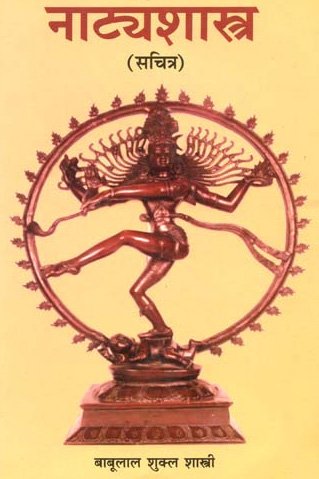
Natyashastra (नाट्यशास्त्र, nāṭyaśāstra) refers to both the ancient Indian tradition (shastra) of performing arts, (natya—theatrics, drama, dance, music), as well as the name of a Sanskrit work dealing with these subjects. It also teaches the rules for composing Dramatic plays (nataka), construction and performance of Theater, and Poetic works (kavya).
Mīmāṃsā (school of philosophy)
Source: Srimatham: Mīmāṃsa: The Study of Hindu ExegesisPhala (फल, “outcomes”) refers to one of the various tools used by authors displaying their skill in the art of writing.—Often at the end of a hymn (stotra) or story various exaggerated results from the recitation or hearing of the passage are mentioned. These are arthavādas and are not to be taken literally—they are included merely to encourage the neophytes. In addition all activities such as chanting hymns or reciting stories of sages and gods have the potential of planting seeds in the mind which hopefully will yield reward at some later stage when the conditions are right.
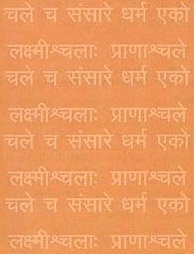
Mimamsa (मीमांसा, mīmāṃsā) refers to one of the six orthodox Hindu schools of philosophy, emphasizing the nature of dharma and the philosophy of language. The literature in this school is also known for its in-depth study of ritual actions and social duties.
Vyakarana (Sanskrit grammar)
Source: Shodhganga: Vaiyākaraṇabhūṣaṇasāra: a critical studyPhala (फल).—Fruit of an action that goes to the agent. It also means the result of a grammatical operation or grammatical injunction.
Source: Wikisource: A dictionary of Sanskrit grammar1) Phala (फल).—Fruit or benefit of an action which goes to the agent; cf. फलव्यापारयोर्धातुः (phalavyāpārayordhātuḥ) Vaiyakarana-bhusana. A root which is given as Ubhayapadin in Panini's Grammar takes the Atmanepada affixes when the fruit of the activity is meant for the agent, while otherwise it takes the Parasmaipada affixes;
2) Phala.—The word फल (phala) also means the result of a grammatical operation or grammatical injunction.
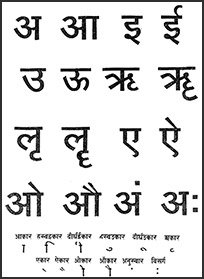
Vyakarana (व्याकरण, vyākaraṇa) refers to Sanskrit grammar and represents one of the six additional sciences (vedanga) to be studied along with the Vedas. Vyakarana concerns itself with the rules of Sanskrit grammar and linguistic analysis in order to establish the correct context of words and sentences.
Ayurveda (science of life)
Nighantu (Synonyms and Characteristics of Drugs and technical terms)
Source: Wisdom Library: Raj NighantuPhala (फल) or Phalavarga is another name for Āmrādi: the eleventh chapter of the 13th-century Raj Nighantu or Rājanighaṇṭu (an Ayurvedic encyclopedia). The Rāja-nighaṇṭu is a medical lexicon ascribed originally known as the Abhidhānacuṇāmaṇi. It mentions the names of 1483 medicinal drugs (auṣadhi) and substances (dravya) excluding synonyms, grouped into twenty-two chapters [viz., Phala-varga].
Dietetics and Culinary Art (such as household cooking)
Source: Shodhganga: Dietetics and culinary art in ancient and medieval IndiaPhala (फल) refers to “fruits”, representing a type of common food commonly found in literature dealing with the topics of dietetics and culinary art, also known as Pākaśāstra or Pākakalā.—The roots (mūla) and fruits (phala) seems to be a common food in śrautasūtra literature. Pāṇini uses the terms bhāji and śrāṇa as the synonyms for cooked vegetables. He mentions the term upadaṃśa which stands for a dish which is prepared by edible roots such as radish and ginger. Āpastamaba states that garlic and onions should be avoided by noble persons.
Phala or “fruits” (part of a plant) represents a type of vegetable (śāka) according to the 17th century Bhojanakutūhala (dravyaguṇāguṇa-kathana).—Śāka-prakaraṇa deals with all types of vegetables. Here vegetables are classified into different plant parts [like fruits (phala), etc.]. Each of these classification have so many varieties. This prakaraṇa is devoted to explain these varieties and their properties in detail.
In the Phala or “fruits” group of foodstuffs, the following substances are beneficial (hita) to the body: Dāḍima (pomegranate), Āmalaka (gooseberry), Drākṣā (grape), Kharjūra (dates), Parūṣaka (small wild date palm), Rājādana (badam) and Mātuluṅga (sweet lime). The following substances are harmful (ahita) to the body: Lakuca (a kind of breadfruit tree).
Toxicology (Study and Treatment of poison)
Source: Shodhganga: Kasyapa Samhita—Text on Visha ChikitsaPhala (फल) or “fruit” refers to one of the ten sources of plant poison, as described in the Kāśyapa Saṃhitā: an ancient Sanskrit text from the Pāñcarātra tradition dealing with both Tantra and Viṣacikitsā—an important topic from Āyurveda which deals with the study of Toxicology (Viṣavidyā or Sarpavidyā).—Kaśyapa states in the fourth Adhyāya that Śiva taught him that poisons are of five kinds viz. immobile, mobile, artificial, caused by planets and (arising out of) doubt. The sources of plant poison, ten in number are [viz. fruit (phala)]. The speed in which they spread too are varied (KS. XII.66):
Unclassified Ayurveda definitions
Source: gurumukhi.ru: Ayurveda glossary of terms1) Phala (फल):—1. Fruit; 2. Therapeutic Result
2) [phalam] Fruits
Source: Chulalongkorn University: Department of Eastern Languages (Pali-Sanskrit Section) (ay)Phāla (फाल) or Phālamaṇi refers to one of the Maṇis (protection amulets) mentioned in the Atharva-veda. Maṇis refer to small round objects made from natural plant parts or from the solid coverings of animal bodies. It has the properties of being an amulet for protection and warding off evil spirits. or as an herb for treating illnesses. Sudev Krishna Sharman G. listed 9 types of Maṇi [e.g., phāla-maṇi—means Acacia catechu)] according to the Atharvaveda including specifying assumptions about the meaning.

Āyurveda (आयुर्वेद, ayurveda) is a branch of Indian science dealing with medicine, herbalism, taxology, anatomy, surgery, alchemy and related topics. Traditional practice of Āyurveda in ancient India dates back to at least the first millenium BC. Literature is commonly written in Sanskrit using various poetic metres.
Nyaya (school of philosophy)
Source: Shodhganga: A study of Nyāya-vaiśeṣika categoriesPhala (फल, “fruit”) refers to one of the twelve prameya (“objects of valid knowledge) according to the first chapter of Gautama’s Nyāyasūtra (2nd century CE). Prameya in turn represents the second of the sixteen padārthas (“categories”). Accordingly, “phala depends upon activity and faults”.

Nyaya (न्याय, nyaya) refers to a school of Hindu philosophy (astika), drawing its subject-matter from the Upanishads. The Nyaya philosophy is known for its theories on logic, methodology and epistemology, however, it is closely related with Vaisheshika in terms of metaphysics.
Ganapatya (worship of Ganesha)
Source: Google Books: Ganapati: Song of the SelfPhala (फल) refers to “fruit”, representing one of the possible preliminary rites (upacāra) of a pūjā (deity worship).—Each act in a pūjā is not only physical and/or mental, but also symbolic, cosmic, and spiritual. Sprinkling, sipping, and bathing are symbolic of purification, of the worshipped as well as of the worshipper and the surroundings. Various offerings [viz., phala] symbolize the surrendering of one’s latent tendencies (vāsanā) as expressed in thoughts, words, and deeds.
Ganapatya (गाणपत्य, gāṇapatya) represents a tradition of Hinduism where Ganesha is revered and worshipped as the prime deity (ishta-devata). Being a minor though influential movement, Ganapatya evovled, llike Shaktism and Shaivism, as a separate movement leaving behind a large body of literature.
Vaishnavism (Vaishava dharma)
Source: Pure Bhakti: Brhad BhagavatamrtamPhala (फल) refers to:—The fruit, or result. (cf. Glossary page from Śrī Bṛhad-bhāgavatāmṛta).

Vaishnava (वैष्णव, vaiṣṇava) or vaishnavism (vaiṣṇavism) represents a tradition of Hinduism worshipping Vishnu as the supreme Lord. Similar to the Shaktism and Shaivism traditions, Vaishnavism also developed as an individual movement, famous for its exposition of the dashavatara (‘ten avatars of Vishnu’).
Jyotisha (astronomy and astrology)
Source: Wisdom Library: Brihat Samhita by VarahamihiraPhala (फल) refers to “fruits”, according to the Bṛhatsaṃhitā (chapter 5), an encyclopedic Sanskrit work written by Varāhamihira mainly focusing on the science of ancient Indian astronomy astronomy (Jyotiṣa).—Accordingly, “If the eclipses should occur before the calculated times, there will be miscarriage of pregnancy and wars in the land; if they should occur after the calculated times, flowers and fruits [i.e., kusuma-phala] will perish and there will be fear in the land and crops. I have described, as above, the effects of the occurrence of eclipses either before or after the calculated times in accordance with the ancient śāstras; but the calculation of a really learned Astronomer will at no time fail”.
Source: Google Books: Studies in the History of the Exact Sciences (Astronomy)Phala (फल) refers to “prognostication”, according to the Ghaṭikāyantraghaṭanāvidhi, an unpublished manuscript entitled citing Nārada as the authority for the ritual connected with the setting up of the water clock and its invocation.—Accordingly, The ritual consists of (i) setting up the basin (kuṇḍa) on a sacred ground; (ii) placing the bowl therein at sunrise or sunset; (iii) the mantra in praise of the water clock; (iv) prognostication (phala) according to the cardinal direction to which the bowl moves when placed on the surface of the water in the basin; (v) and prognostication according to the direction in which the bowl finally sinks; and (vi) the recitation of the so-called palavṛttas.
For this ritual, Cf. the extant version of the Nāradasaṃhitā (before 1365), Rāma Daivajña’s Muhūrtacintāmaṇi (AD 1600) and Govinda Daivajña’s Pīyūṣadhārā commentary (AD 1603).

Jyotisha (ज्योतिष, jyotiṣa or jyotish) refers to ‘astronomy’ or “Vedic astrology” and represents the fifth of the six Vedangas (additional sciences to be studied along with the Vedas). Jyotisha concerns itself with the study and prediction of the movements of celestial bodies, in order to calculate the auspicious time for rituals and ceremonies.
Shaivism (Shaiva philosophy)
Source: Brill: Śaivism and the Tantric TraditionsPhala (फल) refers to “fruits”, according to the Guhyasūtra chapter 9.—Accordingly, “[...] [The Lord spoke]:—[...] In the left hand, he should hold a winnowing fan in the observance of Ardhanārīśvara. Adopting this observance he should eat alms, keep his senses under control, be devoted to regular obligatory recitation and oblation, rejecting the receipt of gifts. He should venerate God three times [a day] and perform ablutions three times [a day]. Eating vegetables and barley-gruel, eating bulbs, roots and fruits (phala-āśin), for one month. [...]”.

Shaiva (शैव, śaiva) or Shaivism (śaivism) represents a tradition of Hinduism worshiping Shiva as the supreme being. Closely related to Shaktism, Shaiva literature includes a range of scriptures, including Tantras, while the root of this tradition may be traced back to the ancient Vedas.
Vastushastra (architecture)
Source: Brill: Śaivism and the Tantric Traditions (architecture)1) Phala (फल) refers to the “reward” (that one gains from establishing images), according to verse 4.243 of the Mohacūrottara (Mohacūḍottara), a Śaiva text from the 10th century.—Accordingly, “The reward (phala) that a wise man gains from establishing a mobile image [i.e. an ascetic] in a maṭha is the same as the reward (phala) that he gains from establishing a fixed image in a temple”.
2) Phala (फल) refers to the “consequences” (of doorways) (at each of the peripheral padas of the 9 by 9 deity map), according to the Devyāmata (chapter 105).—Accordingly, [while describing the consequences of a doorway]—“Thus, in due sequence, the consequences (phala—dvārāṇāṃ phalam) of doorways are given. [With a doorway] at Īśa, the householder will have the risk of fire; at Parjanya, harm from women. At Jaya [the householder] is endowed with wealth. At Māhendra he is dear to the king. At Āditya there is anger. At Satya there is lawful conduct. [...]”.
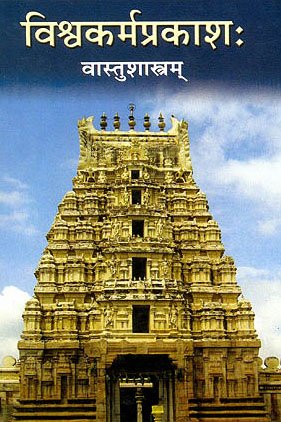
Vastushastra (वास्तुशास्त्र, vāstuśāstra) refers to the ancient Indian science (shastra) of architecture (vastu), dealing with topics such architecture, sculpture, town-building, fort building and various other constructions. Vastu also deals with the philosophy of the architectural relation with the cosmic universe.
Ganitashastra (Mathematics and Algebra)
Source: archive.org: Hindu Mathematics1) Phala (फल) refers to the “result (of multiplication)” in Guṇana (“multiplication”) which represents one of the twenty operations (logistics) of pāṭīgaṇita (“science of calculation which requires the use of writing material—the board”), according to Pṛthudakasvāmī’s commentary on the Brāhmasphuṭasiddhānta by Brahmagupta, a Sanskrit treatise on ancient Indian mathematics (gaṇita-śāstra) and astronomy from the 7th century.—The multiplicator was termed guṇya and the multiplier guṇaka or guṇakāra. The product was called guṇana-phala (result of multiplication) or pratyutpanna (lit. “reproduced”, hence in arithmetic “reproduced by multiplication”). The above terms occur in all known Hindu works.
2) Phala (फल) refers to the “fruit” (being multiplied by the requisition) in Trairāśika (“rule of three”).—According to Āryabhaṭa I in the Āryabhaṭīya: “In the Rule of Three, the phala (‘fruit’), being multiplied by the icchā (‘requisition’) is divided by the pramāṇa (‘argument’). The quotient is the fruit corresponding to the icchā. The denominators of one being multiplied with the other give the multiplier (i.e., numerator) and the divisor (i.e., denominator)”.
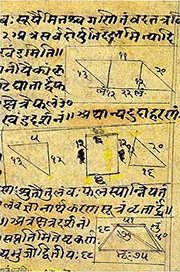
Ganitashastra (शिल्पशास्त्र, gaṇitaśāstra) refers to the ancient Indian science of mathematics, algebra, number theory, arithmetic, etc. Closely allied with astronomy, both were commonly taught and studied in universities, even since the 1st millennium BCE. Ganita-shastra also includes ritualistic math-books such as the Shulba-sutras.
General definition (in Hinduism)
Source: ACHC: Smarta PujaPhala (फल) refers to “offering fruit”, representing one of the various services (upacāra) of a pūjā (ritualistic worship of a deity) which aim at the purification of the devotee.—The worshipper offers a fruit, usually a coconut marked with kunkuma. The coconut—considered as the best of all fruits - figures in almost all religious functions. it is often given to honor a person (in that case it is called srī-phala). In a few contexts it symbolizes a child.
In Buddhism
Theravada (major branch of Buddhism)
Source: Access to Insight: A Glossary of Pali and Buddhist TermsFruition. Specifically, the fruition of any of the four transcendent paths (see magga).Source: Dhamma Dana: Pali English GlossaryN (Fruit) Benefit, effect, consequence.
Source: Pali Kanon: Manual of Buddhist Terms and Doctrines(result of supermundane path): Phala (“fruition”); s. ariyapuggala (A) .
Source: Pali Kanon: Manual of Buddhist Terms and Doctrineslit. 'fruit'. -
-
1. result, effect (often together with hetu, cause );
-
2. benefit (e.g. in Sāmañña-phala Sutta, 'The Results, or Benefits, of Recluseship'; D.2).
As 'path-result', or 'fruition', it denotes those moments of supermundane consciousness which flash forth immediately after the moment of path-consciousness (s. ariya-puggala) and which, till the attainment of the next higher path, may during the practice of insight (vipassanā, q.v.) still recur innumerable times. If thus repeated, they are called the 'attainment of fruition (phalasamāpatti), which is explained in detail in Vis.M. XXIII.
Theravāda is a major branch of Buddhism having the the Pali canon (tipitaka) as their canonical literature, which includes the vinaya-pitaka (monastic rules), the sutta-pitaka (Buddhist sermons) and the abhidhamma-pitaka (philosophy and psychology).
Mahayana (major branch of Buddhism)
Source: academia.edu: A Study and Translation of the GaganagañjaparipṛcchāPhala (फल) refers to the “effect” (of good qualities), according to the Gaganagañjaparipṛcchā: the eighth chapter of the Mahāsaṃnipāta (a collection of Mahāyāna Buddhist Sūtras).—Accordingly, “How then, son of good family, does the Bodhisattva collect all qualities of the Buddha by thorough practice (yoniśas-prayoga)? [...] Learning is the cause of great insight; the Bodhisattva, not being entangled in the preconceived viewpoints, having transferred the learning without apprehending into omniscience, fulfils the perfection of insight. In the same way with all good qualities, whatever the cause of good qualities accumulated, its effect (phala) will appear without effort. Further, the cause and conditions are called thorough mental effort. [...]”.
Source: De Gruyter: A Buddhist Ritual Manual on AgriculturePhala (फल) or Phalasaṃdhāraṇī refers to the “(protection of) fruits” as occurring in the Heart-mantra (hṛdayamantra) taught to Vajrapāṇi, according to the Vajratuṇḍasamayakalparāja, an ancient Buddhist ritual manual on agriculture from the 5th-century (or earlier), containing various instructions for the Sangha to provide agriculture-related services to laypeople including rain-making, weather control and crop protection.

Mahayana (महायान, mahāyāna) is a major branch of Buddhism focusing on the path of a Bodhisattva (spiritual aspirants/ enlightened beings). Extant literature is vast and primarely composed in the Sanskrit language. There are many sūtras of which some of the earliest are the various Prajñāpāramitā sūtras.
Tibetan Buddhism (Vajrayana or tantric Buddhism)
Source: Brill: Śaivism and the Tantric Traditions (tantric Buddhism)Phala (फल) refers to “fruits”, according to the Bhūśalyasūtrapātananimittavidhi section of Jagaddarpaṇa’s Ācāryakriyāsamuccaya, a text within Tantric Buddhism dealing with construction manual for monasteries etc.—Accordingly, “[...] If a parasol, lotus, banner, muraja drum, flagpole, ornament, a woman of the court, fish, milk, the best curd, wine, blazing fire, and fruits (phala) [are seen], then there are victory, extraordinary increase of grain, property, [the number of] sons, and other [merits], and the completion of duties. [...]”.

Tibetan Buddhism includes schools such as Nyingma, Kadampa, Kagyu and Gelug. Their primary canon of literature is divided in two broad categories: The Kangyur, which consists of Buddha’s words, and the Tengyur, which includes commentaries from various sources. Esotericism and tantra techniques (vajrayāna) are collected indepently.
In Jainism
General definition (in Jainism)
Source: Wisdom Library: JainismPhala (फल, “fruit”).—One of the ten kinds of “plant-bodies” (vanaspati) a soul (jīva) can be reborn as due to karma. Phala and other plant-bodies are within the animal world (tiryag-gati) which is one of the four divisions of saṃsāra where souls are reborn.
Source: The University of Sydney: A study of the Twelve ReflectionsPhala (फल) refers to the “result” (of actions), according to the 11th century Jñānārṇava, a treatise on Jain Yoga in roughly 2200 Sanskrit verses composed by Śubhacandra.—Accordingly, “Fools mourn for relations experiencing the results of their own actions (sva-karman-phalabhogin) [but] because of the confusion of [their] intelligence [they do] not [mourn for] themselves situated in Yama’s fangs. In this forest that is the cycle of rebirth dwelt in by Yama the serpent-king, the men of olden times, who were eternal previously, have come to an end”.

Jainism is an Indian religion of Dharma whose doctrine revolves around harmlessness (ahimsa) towards every living being. The two major branches (Digambara and Svetambara) of Jainism stimulate self-control (or, shramana, ‘self-reliance’) and spiritual development through a path of peace for the soul to progess to the ultimate goal.
India history and geography
Source: Cologne Digital Sanskrit Dictionaries: Indian Epigraphical GlossaryPhala.—(IA 27), a Pāli form of Sanskrit pala. Note: phala is defined in the “Indian epigraphical glossary” as it can be found on ancient inscriptions commonly written in Sanskrit, Prakrit or Dravidian languages.

The history of India traces the identification of countries, villages, towns and other regions of India, as well as mythology, zoology, royal dynasties, rulers, tribes, local festivities and traditions and regional languages. Ancient India enjoyed religious freedom and encourages the path of Dharma, a concept common to Buddhism, Hinduism, and Jainism.
Biology (plants and animals)
Source: Wisdom Library: Local Names of Plants and DrugsPhala in the Marathi language is the name of a plant identified with Artocarpus lacucha Buch.-Ham. from the Moraceae (Mulberry) family having the following synonyms: Artocarpus lakoocha, Artocarpus ficifolius. For the possible medicinal usage of phala, you can check this page for potential sources and references, although be aware that any some or none of the side-effects may not be mentioned here, wether they be harmful or beneficial to health.
Source: Google Books: CRC World Dictionary (Regional names)1) Phala in India is the name of a plant defined with Artocarpus gomezianus in various botanical sources. This page contains potential references in Ayurveda, modern medicine, and other folk traditions or local practices It has the synonym Artocarpus gomezianus Wall., nom. nudum.
2) Phala is also identified with Artocarpus lakoocha It has the synonym Artocarpus lakoocha Wall. ex Roxb. (etc.).
Example references for further research on medicinal uses or toxicity (see latin names for full list):
· A Numerical List of Dried Specimens (4660)
· Acta Phytotaxonomica Sinica (1957)
· Flora Indica (1832)
· Mem. Wern. Soc. (1826)
· Taxon (1977)
· Pharmaceutical Biology (2005)
If you are looking for specific details regarding Phala, for example health benefits, side effects, pregnancy safety, extract dosage, chemical composition, diet and recipes, have a look at these references.

This sections includes definitions from the five kingdoms of living things: Animals, Plants, Fungi, Protists and Monera. It will include both the official binomial nomenclature (scientific names usually in Latin) as well as regional spellings and variants.
Languages of India and abroad
Pali-English dictionary
Source: BuddhaSasana: Concise Pali-English Dictionaryphala : (nt.) fruit; nut; result; consequence; fruition; the blade of a weapon. || phāla (m.) 1. a ploughshare; 2. an instrument to split wood; 3. one half or a slice of salted fish, etc.
Source: Sutta: The Pali Text Society's Pali-English Dictionary1) Phala, 3 (etym. ? Sk. *phala) the point of a spear or sword S. II, 265 (tiṇha°). Cp. phāla2. (Page 477)
2) Phala, 2 is spelling for pala (a certain weight) at J. VI, 510. See pala & cp. Geiger, P. Gr. § 40. (Page 477)
3) Phala, 1 (nt.) (cp. Vedic phala, to phal (sphal) to burst, thus lit. “bursting, ” i.e. ripe fruit; see phalati) 1. (lit.) fruit (of trees etc.) Vv 8414 (dumā nicca-phal’ûpapannā, not to phalu, as Kern, Toev. s. v. phalu); Vism. 120.—amba° mango-fruit PvA. 273 sq.; dussa° (adj.) having clothes as their fruit (of magic trees) Vv 462 (cp. VvA. 199); patta° leaves & fruits, vegetables Sn. 239; PvA. 86 pavatta° wild fruit D. I, 101; puppha° flower & fruit J. III, 40. rukkha°-ûpama Th. 1, 490 (in simile of kāmā, taken fr. M. I, 130) lit. “like the fruit of trees” is expld by ThA. 288 as “aṅga-paccaṅgānaṃ p(h)alibhañjan’aṭṭhena, and trsld according to this interpretation by Mrs. Rh. D. as “fruit that brings the climber to a fall. ” — Seven kinds of medicinal fruits are given at Vin. I, 201 scil. vilaṅga, pippala, marica, harītaka, vibhītaka, āmalaka, goṭhaphala. At Miln. 333 a set of 7 fruits is used metaphorically in simile of the Buddha’s fruit-shop, viz. sotāpatti°, sakadāgāmi°, anāgāmi°, arahatta°, suññata° samāpatti (cp. Cpd. 70), animitta° samāpatti, appaṇihita° samāpatti.—2. a testicle J. III, 124 (dantehi °ṃ chindati=purisabhāvaṃ nāseti to castrate); VI, 237 (uddhita-pphalo, adj. , =uddhaṭa-bījo C.), 238 (dantehi phalāni uppāṭeti, like above). ‹-› 3. (fig.) fruit, result, consequence, fruition, blessing. As t. t. with ref. to the Path and the progressive attainment (enjoyment, fruition) of Arahantship it is used to denote the realization of having attained each stage of the sotāpatti, sakadāgāmi etc. (see the Miln. quot. under 1 and cp. Cpd. 45, 116). So frequent in exegetical literature magga, phala, nibbāna, e.g. Tikp 155, 158; VbhA. 43 & passim.—In general it immediately precedes Nibbāna (see Nd2 no 645b and under satipaṭṭhāna), and as agga-phala it is almost identical with Arahantship. Frequently it is combd with vipāka to denote the stringent conception of “consequence, ” e.g. at D. I, 27, 58; III, 160. Almost synonymous in the sense of “fruition, benefit, profit” is ānisaṃsā D. III, 132; phala at Pv. I, 125=ānisaṃsa PvA. 64 — Vin. I, 293 (anāgāmi°); II, 240 (id.); III, 73 (arahatta°); D. I, 51, 57 sq. (sāmañña°); III, 147, 170 (sucaritassa); M. I, 477 (appamāda°); S. I, 173 (Amata°); Pv. I, 1110 (kaṭuka°); II, 83 (dāna°); IV, 188 (mahap° & agga°); Vism. 345 (of food, being digested); PvA. 8 (puñña° & dāna°), 22 (sotāpatti°), 24 (issā-macchariya°).—atthika one who is looking for fruit Vism. 120.—āpaṇa fruit shop Miln. 333.—âphala (phala+aphala, see ā4; but cp. Geiger, P. Gr. § 331) all sorts of fruit, lit. what is not (i.e. unripe), fruit without discrimination; a phrase very frequent in Jātaka style, e.g. J. I, 416; II, 160; III, 127; IV, 220; 307, 449, V, 313; VI, 520; DhA. I, 106.—āsava extract of fruit VvA. 73.—uppatti ripening PvA. 29.—esin yielding fruit J. I, 87=Th. 1, 527, cp. phalesin MVastu III, 93.—gaṇḍa see palagaṇḍa.—ṭṭha “stationed in fruition, ” i.e. enjoying the result or fruition of the Path (cp. Cpd. 50) Miln. 342.—dāna gift of fruit VbhA. 337.—dāyin giver of fruit Vv 676.—pacchi fruit-basket J. VI, 560.—pañcaka fivefold fruit Vism. 580; VbhA. 191.—puṭa fruit-basket J. VI, 236.—bhājana one who distributes fruit, an official term in the vihāra Vin. IV, 38, cp. BSk. phalacāraka.—maya see sep.—ruha fruit tree Mbvs 82.—sata see palasata. (Page 477)
— or —
1) Phāla, 3 in loṇa-maccha° a string (?) or cluster of salted fish Vism. 28. (Page 478)
2) Phāla, 2 (to phala3) an (iron) board, slab (or ball?), maybe spear or rod. The word is of doubtful origin & meaning, it occurs always in the same context of a heated iron instrument, several times in correlation with an iron ball (ayogula). It has been misunderstood at an early time, as is shown by kapāla A. IV, 70 for phāla. Kern comments on the word at Toev. II. 139. See Vin. I, 225 (phālo divasantatto, so read; v. l. balo corr. to bālo; corresp. with guḷa); A. IV, 70 (divasa-santatte ayokapāle, gloss ayogule); J. V, 268; V, 109 (phāle ciraratta-tāpite, v. l. pāle, hale, thāle; corresp. with pakaṭṭhita ayogula), id. V, 113 (ayomayehi phālehi pīḷeti, v. l. vālehi). (Page 478)
3) Phāla, 1 (m. & nt.) (cp. Vedic phāla) ploughshare S. I, 169; Sn. p. 13 & V, 77 (expld as “phāletī ti ph. ” SnA 147); J. I, 94; IV, 118; V, 104; Ud. 69 (as m.); DhA. I, 395. (Page 478)

Pali is the language of the Tipiṭaka, which is the sacred canon of Theravāda Buddhism and contains much of the Buddha’s speech. Closeley related to Sanskrit, both languages are used interchangeably between religions.
Marathi-English dictionary
Source: DDSA: The Molesworth Marathi and English Dictionaryphala (फल).—n (S) Fruit or a fruit. 2 Fruit metaphorically, viz. offspring or progeny; advantage or profit; product or produce; effect or consequence (as of an action). 3 A common name for two terms of the Rule of three, viz. that which expresses the subject of the given rate, and that which expresses the answer. 4 The iron head of a spear or an arrow; the blade of a weapon or tool. 5 The area of a circle. phalāphala pāhūna karāvēṃ Consider the advantages and evils of, the pros and cons of.
--- OR ---
phaḷa (फळ).—n (phala S which see throughout.) Fruit or a fruit, lit. fig. 2 Abridged from phaḷapradāna, for which see phalapradāna. 3 A coarse kind of cake dressed by steam. 4 A potter's patter.
--- OR ---
phaḷā (फळा).—m (Commonly phāḷa) A ploughshare. 2 (Intens. of phaḷī) A large plank or board. 3 fig. A board or layer of the material (solution of hemp &c.) which, on drying, becomes paper.
--- OR ---
phāḷa (फाळ).—m (phāla S) A ploughshare. 2 fig. An extravagantly broad nib of a reed pen.
--- OR ---
phāḷa (फाळ).—f (phāḷaṇēṃ) A largish slip (as struck off with a hatchet) from a piece of timber. 2 C A slip or shred; a narrow and long piece gen.
--- OR ---
phāḷā (फाळा).—m (phāḷaṇēṃ) A shred, a slip, a torn off piece. 2 A rent or slit. v kāḍha, nigha, jā. 3 A roll of spun silk. Fourteen such rolls compose a thōka or half a śēriyā. 4 A share of an assessment or tax. 5 A share of a distribution gen. 6 (Commonly phāḷa) A ploughshare. phāḷā phāḍaṇēṃ To distribute and apportion a paṭṭī or cess.
Source: DDSA: The Aryabhusan school dictionary, Marathi-Englishphala (फल).—n Fruit or a fruit. Offspring or pro- gency. Advantage, effect or conse- quence. The area of a circle. phalāphala pāhūna karāvēṃ Consider the advantages and evils of, the pros and cons of.
--- OR ---
phaḷa (फळ).—n A fruit. paḍatyā phaḷācī ājñā or paravānagī Used when a permission is stretched to justify acts not contemplated by the person granting it. phaḷāsa or phaḷāṃ yēṇēṃ. To become productive or profita- ble; to yield fruit or advantage.
--- OR ---
phaḷā (फळा).—m A ploughshare. A large plank or board.
--- OR ---
phāḷa (फाळ) [-ḷā, -ळा].—m A ploughshare. An extra- vagantly broad nib of a reed pen.
--- OR ---
phāḷā (फाळा).—m A shred. A rend. A roll of spun silk. A share of an assessment or tax. A share of a distribution. A ploughshare. phāḷā phāḍaṇēṃ To distribute and apportion a paṭṭī or cess.
Marathi is an Indo-European language having over 70 million native speakers people in (predominantly) Maharashtra India. Marathi, like many other Indo-Aryan languages, evolved from early forms of Prakrit, which itself is a subset of Sanskrit, one of the most ancient languages of the world.
Sanskrit dictionary
Source: DDSA: The practical Sanskrit-English dictionaryPhala (फल).—[phal-ac]
1) Fruit (fig. also) as of a tree; उदेति पूर्वं कुसुमं ततः फलम् (udeti pūrvaṃ kusumaṃ tataḥ phalam) Ś.7.3; R.4.43;1.49.
2) Crop, produce; कृषिफलम् (kṛṣiphalam) Meghadūta 16.
3) A result, fruit, consequence, effect; अत्युत्कटैः पापपुण्यैरिहैव फलमश्नुते (atyutkaṭaiḥ pāpapuṇyairihaiva phalamaśnute) H.1.8; फलेन ज्ञास्यसि (phalena jñāsyasi) Pañcatantra (Bombay) 1; न नवः प्रभुराफलोदयात् स्थिरकर्मा विरराम कर्मणः (na navaḥ prabhurāphalodayāt sthirakarmā virarāma karmaṇaḥ) R.8.22;1.33; अनिष्टमिष्टं मिश्रं च त्रिविधं कर्मणः फलम् (aniṣṭamiṣṭaṃ miśraṃ ca trividhaṃ karmaṇaḥ phalam) Bhagavadgītā (Bombay) 18.12.
4) (Hence) Reward, recompense, meed, retribution (good or bad); फलमस्योपहासस्य सद्यः प्राप्स्यसि पश्य माम् (phalamasyopahāsasya sadyaḥ prāpsyasi paśya mām) R.12.37.
5) A deed, act (opp. words); ब्रुवते हि फलेन साधवो न तु कण्ठेन निजोपयोगिताम् (bruvate hi phalena sādhavo na tu kaṇṭhena nijopayogitām) N.2.48 'good men prove their usefulness by deeds, not by words'.
6) Aim, object, purpose; परेङ्गितज्ञानफला हि बुद्धयः (pareṅgitajñānaphalā hi buddhayaḥ) Pañcatantra (Bombay) 1.43; किमपेक्ष्य फलम् (kimapekṣya phalam) Kirātārjunīya 2.21, 'with what object in view; Meghadūta 56.
7) Use, good, profit, advantage; जगता वा विफलेन किं फलम् (jagatā vā viphalena kiṃ phalam) Bv.2.61.
8) Profit or interest on capital.
9) Progeny, offspring; तस्यापनोदाय फलप्रवृत्तावुपस्थितायामपि निर्व्यपेक्षः (tasyāpanodāya phalapravṛttāvupasthitāyāmapi nirvyapekṣaḥ) (tyakṣāmi) R.14.39.
1) A kernel (of a fruit).
11) A tablet or board (śāriphala).
12) A blade (of a sword).
13) The point or head of an arrow, dart &c.; barb; आरामुखं क्षुरप्रं च गोपुच्छं चार्धचन्द्रकम् । सूचीमुखं च भल्लं च वत्सदन्तं द्विभल्लकम् ॥ कर्णिकं काकतुण्डं च तथान्यान्यप्यनेकशः । फलानि देशभेदेन भवन्ति बहुरूपतः (ārāmukhaṃ kṣurapraṃ ca gopucchaṃ cārdhacandrakam | sūcīmukhaṃ ca bhallaṃ ca vatsadantaṃ dvibhallakam || karṇikaṃ kākatuṇḍaṃ ca tathānyānyapyanekaśaḥ | phalāni deśabhedena bhavanti bahurūpataḥ) || Dhanur.64-5; फलयोगमवाप्य सायकानाम् (phalayogamavāpya sāyakānām) Manusmṛti 7.1; Kirātārjunīya 14.52.
14) A shield.
15) A testicle; अकर्तव्यमिदं यस्माद् विफलस्त्वं भविष्यसि (akartavyamidaṃ yasmād viphalastvaṃ bhaviṣyasi) Rām.1.48.27.
16) A gift.
17) The result of a calculation (in Math.)
18) Product or quotient.
19) Menstrual discharge.
2) Nutmeg.
21) A ploughshare.
22) Loss, disadvantage.
23) The second (or third) term in a rule-of-three sum.
24) Correlative equation.
25) The area of a figure.
26) The three myrobalans (triphalā).
27) A point on a die.
28) Benefit, enjoyment; ईश्वरा भूरिदानेन यल्लभन्ते फलं किल (īśvarā bhūridānena yallabhante phalaṃ kila) Pañcatantra (Bombay) 2.72.
29) Compensation; यावत् सस्यं विनश्येत् तु तावत् स्यात् क्षेत्रिणः फलम् (yāvat sasyaṃ vinaśyet tu tāvat syāt kṣetriṇaḥ phalam) Y.2.161.
3) A counterpart (pratibimba); तन्मायाफलरूपेण केवलं निर्विकल्पितम् (tanmāyāphalarūpeṇa kevalaṃ nirvikalpitam) Bhāgavata 11.24.3.
31) Shoulder-blade; तस्यां स फलके खड्गं निजघान ततोऽङ्गदः (tasyāṃ sa phalake khaḍgaṃ nijaghāna tato'ṅgadaḥ) Rām.6.76.1.
Derivable forms: phalam (फलम्).
--- OR ---
Phāla (फाल).—1 A ploughshare; Manusmṛti 6.16.
2) Separation of the hair on each side of the head (sīmāntabhāga); द्विफालबद्धाश्चिकुराः शिरःस्थितम् (dviphālabaddhāścikurāḥ śiraḥsthitam) N.1.16.
3) A sort of spade.
4) A bundle.
5) The forehead (for bhāla).
-laḥ 1 An epithet of Balarāma.
2) Of Śiva.
3) The citron. tree.
-lam 1 A garment of cotton.
2) A ploughed field.
Derivable forms: phālaḥ (फालः), phālam (फालम्).
Source: Cologne Digital Sanskrit Dictionaries: Edgerton Buddhist Hybrid Sanskrit DictionaryPhala (फल).—nt. (1) (= Sanskrit and Pali phalaka) bark, bast (used for garments): phala-muñjāsana-valkala…Lalitavistara 249.1 (prose); (2) (= Sanskrit and Pali id.) religious fruition or attainment, passim; prathama phala Mahāvastu i.174.12, 14; [Page396-a+ 71] 192.7, 8, = the first stage of religious advancement, compare śrotāpattiphale i.175.1; five phalāni, sc. of karuṇā, com- passion, according to Asaṅga (Mahāyāna-sūtrālaṃkāra) xvii.31 with commentary, which explains all five, in different order: Mahāvyutpatti 2271-7, niṣyanda-, adhi- pati-, puruṣakāra-, vipāka-, visaṃyoga- phalam (see the various prior members). However, nothing is said of karuṇā in Mahāvyutpatti, and it probably intends them as different kinds of results of anything; so Bodhisattvabhūmi 102.16 ff. and Abhidharmakośa LaV-P. ii.287 ff., iv.185 ff. treat the same terms.
Source: Cologne Digital Sanskrit Dictionaries: Shabda-Sagara Sanskrit-English DictionaryPhala (फल).—n.
(-laṃ) 1. The fruit of any plant, fruit in general. 2. Fruit, (metaphorically,) result, produce, consequence. 3. Prosperity, flourishing, thriving. 4. Gain, profit, acquisition. 5. Recompense, reward. 6. A shield. 7. The blade of a sword or knife, the head of an arrow, &c. 8. A sort of fragrant berry and drug commonly Kakoli. 9. A nutmeg. 10. The three myrobalans collectively. 11. The men- strual discharge. 12. Gift, giving. 13. A ploughshare. 14. The quotient of a sum, (in arithmetic.) 15. The area of a circle, &c. 16. An equation. 17. (In astronomy,) The anomalistic equation of a planet. f. (-lī) A medicinal plant, commonly Priangu. m.
(-laḥ) A plant, (Echites anti-dysenterica, Rox.:) see kuṭaja. E. phal to bear or produce fruit, aff. ac .
--- OR ---
Phāla (फाल).—mfn.
(-laḥ-lā-laṃ) Made of cotton, (vesture.) m.
(-laḥ) 1. A name of Siva. 2. A name of Balarama. 3. A citron tree. n.
(-laṃ) The share of a plough. E. phal to divide, in the causal form. aff. ghañ or phala fruit and aṇ aff.
Source: Cologne Digital Sanskrit Dictionaries: Benfey Sanskrit-English DictionaryPhala (फल).—[phal + a], n. 1. Fruit, [Uttara Rāmacarita, 2. ed. Calc., 1862.] 33, 8. 2. Revenue, [Hitopadeśa] iv. [distich] 121. 3. Consequence,
--- OR ---
Phāla (फाल).—i. e. phal + a, I. m. n. The share of a plough, [Mānavadharmaśāstra] 4, 46; 6, 16. Ii. m. A name of Śiva and Balarāma.
Source: Cologne Digital Sanskrit Dictionaries: Cappeller Sanskrit-English DictionaryPhala (फल).—[neuter] (adj. —° [feminine] ā & ī) fruit, [especially] of a tree, kernel, testicle; fruit i.e. result, profit, gain, reward or punishment, compensation, interest on capital; tablet, board, blade, point of an arrow. [feminine] ā & ī names of plants.
--- OR ---
Phāla (फाल).—[masculine] (*[neuter]) ploughshare or a kind of shovel; bundle, bunch, nosegay.
Source: Cologne Digital Sanskrit Dictionaries: Monier-Williams Sanskrit-English Dictionary1) Phala (फल):—[from phal] n. (ifc. f(ā or ī). ) fruit ([especially] of trees), [Ṛg-veda] etc. etc.
2) [v.s. ...] the kernel or seed of a fruit, [Amaru-śataka]
3) [v.s. ...] a nutmeg, [Suśruta]
4) [v.s. ...] the 3 myrobalans (= tri-phalā q.v.), [cf. Lexicographers, esp. such as amarasiṃha, halāyudha, hemacandra, etc.]
5) [v.s. ...] the menstrual discharge, [cf. Lexicographers, esp. such as amarasiṃha, halāyudha, hemacandra, etc.] (cf. puṣpa)
6) [v.s. ...] fruit (met.), consequence, effect, result, retribution (good or bad), gain or loss, reward or punishment, advantage or disadvantage, [Kātyāyana-śrauta-sūtra; Mahābhārata; Kāvya literature] etc.
7) [v.s. ...] benefit, enjoyment, [Pañcatantra ii, 70]
8) [v.s. ...] compensation, [Yājñavalkya ii, 161]
9) [v.s. ...] (in [rhetoric]) the issue or end of an action, [Daśakumāra-carita; Sāhitya-darpaṇa]
10) [v.s. ...] (in [mathematics]) the result of a calculation, product or quotient etc., [Sūryasiddhānta]
11) [v.s. ...] corrective equation, [ib.; Golādhyāya]
12) [v.s. ...] area or superficial contents of a figure, [Āryabhaṭa]
13) [v.s. ...] interest on capital, [ib.]
14) [v.s. ...] the third term in a rule of three sum, [ib. [Scholiast or Commentator]]
15) [v.s. ...] a gift, donation, [cf. Lexicographers, esp. such as amarasiṃha, halāyudha, hemacandra, etc.]; a gaming board, [Mahābhārata]
16) [v.s. ...] cf. [Gothic] spilda; [Icelandic] spjald
17) [v.s. ...] a blade (of a sword or knife), [Mahābhārata; Rāmāyaṇa; Kumāra-sambhava]
18) [v.s. ...] the point of an arrow, [Kauśika-sūtra]
19) [v.s. ...] a shield, [cf. Lexicographers, esp. such as amarasiṃha, halāyudha, hemacandra, etc.]
20) [v.s. ...] a ploughshare (= phāla), [cf. Lexicographers, esp. such as amarasiṃha, halāyudha, hemacandra, etc.]
21) [v.s. ...] a point or spot on a die, [Mahābhārata iv, 24]
22) [v.s. ...] m. Wrightia Antidysenterica, [cf. Lexicographers, esp. such as amarasiṃha, halāyudha, hemacandra, etc.]
23) Phalā (फला):—[from phala > phal] f. a species of plant, [Caraka]
24) [v.s. ...] [wrong reading] for tula, [Hemādri’s Caturvarga-cintāmaṇi]
25) Phāla (फाल):—[from phal] a m. (or n., [cf. Lexicographers, esp. such as amarasiṃha, halāyudha, hemacandra, etc.]) a ploughshare, [Ṛg-veda; Kāṭhaka; Kauśika-sūtra; Yājñavalkya]
26) [v.s. ...] a kind of hoe or shovel, [Rāmāyaṇa]
27) [v.s. ...] a bunch or bundle, [Naiṣadha-carita]
28) [v.s. ...] a nosegay, [Bālarāmāyaṇa]
29) [v.s. ...] a jump, [Vikramāṅkadeva-carita, by Bilhaṇa; Hemacandra’s Pariśiṣṭaparvan]
30) [v.s. ...] the core of a citron, [cf. Lexicographers, esp. such as amarasiṃha, halāyudha, hemacandra, etc.]
31) [v.s. ...] Name of Śiva, [cf. Lexicographers, esp. such as amarasiṃha, halāyudha, hemacandra, etc.]
32) [v.s. ...] of Bala-rāma, [cf. Lexicographers, esp. such as amarasiṃha, halāyudha, hemacandra, etc.]
33) [v.s. ...] n. a garment of cotton, [Apte’s The Practical Sanskrit-English Dictionary]
34) [v.s. ...] a ploughed field, [ib.]
35) [v.s. ...] = (or [wrong reading] for) bhāla, the forehead, [Catalogue(s)]
36) [v.s. ...] mf(ī)n. made of cotton, [cf. Lexicographers, esp. such as amarasiṃha, halāyudha, hemacandra, etc.]
37) b etc. See p. 717, col. 3.
Source: Cologne Digital Sanskrit Dictionaries: Yates Sanskrit-English Dictionary1) Phala (फल):—phalati 1. a. To produce or bear fruit, to fructify; to go. (ñi, ā) to divide; split.
2) (laṃ) 1. n. Fruit; prosperity; gain; a shield; a blade; a berry; nutmeg; menses; a gift; plough-share; quotient; area of a circle; equation. m. f. A plant (Echites antidysenterica).
3) Phāla (फाल):—(laḥ) 1. m. A name of a Shiva; of Balarāma. n. A plough share a. Made of cotton (clothes).
Source: DDSA: Paia-sadda-mahannavo; a comprehensive Prakrit Hindi dictionary (S)Phala (फल) in the Sanskrit language is related to the Prakrit words: Phara, Pharaa, Phala, Phalāva, Phāla, Phālā.
[Sanskrit to German]
Sanskrit, also spelled संस्कृतम् (saṃskṛtam), is an ancient language of India commonly seen as the grandmother of the Indo-European language family (even English!). Closely allied with Prakrit and Pali, Sanskrit is more exhaustive in both grammar and terms and has the most extensive collection of literature in the world, greatly surpassing its sister-languages Greek and Latin.
Hindi dictionary
Source: DDSA: A practical Hindi-English dictionary1) Phala (फल) [Also spelled fal]:—(nm) a fruit, reward, return; effect; outcome, result, consequence; product; the point of a cutting or piercing instrument; a ploughshare; ~[ta]: consequently; therefore; accordingly; thus; ~[da/dāyaka/dāyī/prada] fruitful, fructuous; profitable; advantageous; productive; fruit-yielding, efficacious; effective; ~[dāna] the first present made from the bride’s side to the bridegroom as a confirmation of the agreement for marriage; ~[dāra] fructiferous, having/bearing fruits; profitable; -[prāpti] fructification; achievement, accomplishment, acquisition of the result; ~[bhakṣī] frugivorous; ~[bhāgī] one who enjoys or suffers the result of a deed; ~[bhoga] suffering or enjoying the result of a deed; ~[mūlaka] pragmatic; ~[yukta] bearing fruits, fruitful, fructuous; ~[vatī] fruitful, fructuous; ~[vāda] pragmatism; ~[vādī] pragmatic; a pragmatist; ~[vāna] fructuous; fruitful, profitable; with fruits; ~[śarkarā] fructose, fruit-sugar; ~[svarūpa] as a result of; ~[hārī] see ~[phalāhārī; ~hīna] fruitless; —[ānā] to fructify, (a tree) to bear fruits; to bring results; —[khānā] to enjoy the reward of one’s good deeds; to reap the harvest of virtuous deeds; —[cakhanā] to suffer/face the consequences of; —[denā] to yield fruit/result; to fructify; —[pānā] to be rewarded; to face the result of, to suffer for one’s evil deeds; —[honā] to be the outcome of.
2) Phalā (फला):—(nf) a fluke.
3) Phāla (फाल) [Also spelled fal]:—(nm) a blade, ploughshare; a stride/pace, measure of one pace; betelnut-paring.
4) Phala (फल) [Also spelled fal]:—[=फ़ॉल] (nm) a fall (in sari:, etc.).
...
Prakrit-English dictionary
Source: DDSA: Paia-sadda-mahannavo; a comprehensive Prakrit Hindi dictionary1) Phala (फल) in the Prakrit language is related to the Sanskrit word: Phal.
2) Phala (फल) also relates to the Sanskrit word: Phala.
3) Phāla (फाल) also relates to the Sanskrit word: Phāla.
4) Phālā (फाला) also relates to the Sanskrit word: Phālā.
Prakrit is an ancient language closely associated with both Pali and Sanskrit. Jain literature is often composed in this language or sub-dialects, such as the Agamas and their commentaries which are written in Ardhamagadhi and Maharashtri Prakrit. The earliest extant texts can be dated to as early as the 4th century BCE although core portions might be older.
Kannada-English dictionary
Source: Alar: Kannada-English corpusPhala (ಫಲ):—
1) [noun] any plant product, as grain, flax, vegetables, etc; a fruit.
2) [noun] the edible plant structure of a mature ovary of a flowering plant, usu. eaten raw; a fruit.
3) [noun] the result, product or consequence of any action.
4) [noun] the object, end or purpose for which something is used; a use.
5) [noun] a strong wish or craving; a desire.
6) [noun] the periodic flow of blood and sloughed-off tissue from the uterus, discharged through the genital tract; menstrual flow; menses.
7) [noun] the cutting edge of a sword, knife, etc.
8) [noun] a long, broad, thick wooden board; a plank.
9) [noun] a broad, metal plate used by soldiers, policemen, to ward of blow and missiles; a shield.
10) [noun] a kind of flat percussion instrument, with a short brim, on which a skin membrane is tightly spread, and usu. played with two sticks.
11) [noun] the long wooden shaft of a plough.
12) [noun] the share of a plough; a plough-share.
13) [noun] the measure of a bounded region on a plane; area.
14) [noun] (math.) the quantity obtained by multiplying two or more quantities together; the product.
15) [noun] (math.) the quantity obtained by dividing a quantity from another quantity; quotient.
16) [noun] (math.) the second of the three quantities, used to find the fourth one.
17) [noun] the condition, quality or period of being pregnant; pregnancy.
18) [noun] a large, smooth, usu. dark surface of slate or other material on which to write or draw with chalk; chalkboard; a black-board.
19) [noun] ಫಲವಾಗು [phalavagu] phalavāgu to bear fruit or fruits; 2. to become useful; to become beneficial; 3. to be accomplished, fulfilled; 4. (an embryo or foetus) to be conceived; ಫಲ ನಿಲ್ಲು [phala nillu] phala nillu (an embryo or foetus) to be conceived.
--- OR ---
Phala (ಫಲ):—[noun] an archaic gold coin.
--- OR ---
Phaḷa (ಫಳ):—[noun] = ಫಲ [phala]1.
--- OR ---
Phāla (ಫಾಲ):—
1) [noun] the cutting blade of a plough; a plough share.
2) [noun] a collection of things usu. of the same kind tied, bundled or grouped together and considered as a single unit; a bunch.
3) [noun] the part of the face above the eyebrows; the forehead.
4) [noun] a garment of cotton.
--- OR ---
Phāḷa (ಫಾಳ):—[noun] a part or fragment broken or separated from the whole; a piece.
Kannada is a Dravidian language (as opposed to the Indo-European language family) mainly spoken in the southwestern region of India.
See also (Relevant definitions)
Starts with (+404): Phala Citta, Phala Jataka, Phala Sutta, Phala-choepa, Phala-divya, Phala-hanahana, Phala-Kana-Kana-Kara-Dini-Dishi, Phala-kantak, Phala-kuhaune-aumsa, Phala-sampenga, Phala-samskara, Phalaa, Phalabandhin, Phalabandhya, Phalabdhi, Phalabhadra, Phalabhaga, Phalabhagin, Phalabhaj, Phalabhaji.
Ends with (+858): Abdhiphala, Abhishtaphala, Acchadanaphala, Acyutaphala, Adattaphala, Adhakiphala, Adhikamasaphala, Adrishtaphala, Agamaphala, Aggaphala, Agniphala, Agraphala, Ahiphala, Ajinaphala, Ajodumbaraphala, Akalaphala, Akasako-phala, Akasaphala, Akashe-phala, Akatuphala.
Full-text (+1584): Aphala, Phullaphala, Caruphala, Phalabhaj, Phalahani, Tamraphala, Suphala, Katuphala, Bhanuphala, Svaduphala, Dantaphala, Anamshumatphala, Ajinaphala, Phalatrika, Sadaphala, Shriphala, Tikshnaphala, Jaghanephala, Phalamukhya, Phalapaka.
Relevant text
Search found 187 books and stories containing Phala, Phāla, Phaḷa, Phaḷā, Phalā, Phāḷa, Phāḷā, Phālā; (plurals include: Phalas, Phālas, Phaḷas, Phaḷās, Phalās, Phāḷas, Phāḷās, Phālās). You can also click to the full overview containing English textual excerpts. Below are direct links for the most relevant articles:
Garga Samhita (English) (by Danavir Goswami)
Verse 6.10.28 < [Chapter 10 - In the Description of the Gomatī River, the Glories of Cakra-tīrtha]
Verse 4.8.35 < [Chapter 8 - In the Story of the Yajña-sītās, the Glories of Ekādaśī]
Verses 3.10.24-25 < [Chapter 10 - The Glory of Śrī Girirāja]
Rig Veda (translation and commentary) (by H. H. Wilson)
Maha Prajnaparamita Sastra (by Gelongma Karma Migme Chödrön)
II. Objections against the efficacy of the conditions < [Part 1 - Understanding the Conditions (pratyaya)]
II.4. The Dharma is independent of time (akālika) < [II. Recollection of the Dharma (dharmānusmṛti)]
Part 5 - Explanation of the word ‘samaye’ < [Chapter II - Evam Mayā Śrutam Ekasmin Samaye]
Manusmriti with the Commentary of Medhatithi (by Ganganatha Jha)
Verse 3.139 < [Section VIII - Śrāddhas]
Verse 9.52 < [Section III - To whom does the Child belong?]
Verse 3.142 < [Section VIII - Śrāddhas]
The Great Chronicle of Buddhas (by Ven. Mingun Sayadaw)
Part 11 - The Attainment of Buddhahood < [Chapter 7 - The Attainment of Buddhahood]
Part 5 - The Six Supreme Attributes of the Dhamma < [Chapter 42 - The Dhamma Ratanā]
Dhamma attributes (1): Svākkhātā < [Chapter 42 - The Dhamma Ratanā]
Vivekachudamani (by Shankara)
Related products
(+2 more products available)









